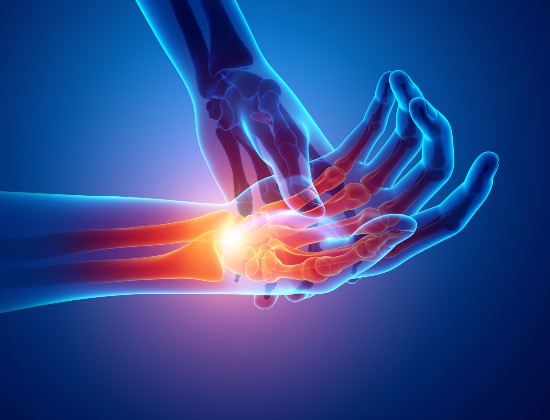Distal radius fracture
This type of fracture, which is very common, affects the larger of the forearm bones – the radius – near to the wrist (the distal end). There are many ways that the distal radius can be broken.
These include:
- Colles fracture – one of the most common types, where the radius bone tilts upwards at the place it’s broken
- Intra-articular (meaning ‘within the joint’) fracture – this type of break extends into the wrist joint
- Extra-articular (meaning ‘outside the joint’) fracture – this type of fracture doesn’t affect the joint
- Open fracture – where the bone breaks through the skin, needing urgent medical treatment
- Comminuted fracture – where the bone is broken in more than two places
Causes
This type of break is usually caused by falling onto your arm when it’s outstretched.
Symptoms
Pain, swelling, tenderness and in some cases deformity where the bone has broken are common symptoms.
Diagnosis
Having discussed how your wrist was injured, the specialist will usually confirm the diagnosis with X-rays to show the type of fracture and whether the bones have become displaced (moved out of alignment).
Treatment
Non-operative treatment: if you have a simple fracture that is not displaced, it may heal by being immobilised with a cast or splint for around six weeks. If the bones are displaced, you may need to have a procedure to realign them (known as ‘reduction’). Sometimes it’s possible for the specialist to straighten the bone without having to open the skin, after which your wrist will be immobilised in a cast or splint for around six weeks. You may be offered regular X-rays or CT scans to check how well it’s healing, along with gentle exercises to help rebuild strength and increase flexibility.
Surgery: if the bone is displaced or comminuted, you may need an operation to realign the bone so it can heal correctly. Sometimes pins, plates or screws are used to keep the bones straight. If the fracture is surgically stabilised with the most modern types of plates, mobilisation of the wrist, without a cast, is often possible.
Important: This information is only a guideline to help you understand your treatment and what to expect. Everyone is different and your rehabilitation may be quicker or slower than other people’s. Please contact us for advice if you’re worried about any aspect of your health or recovery.


